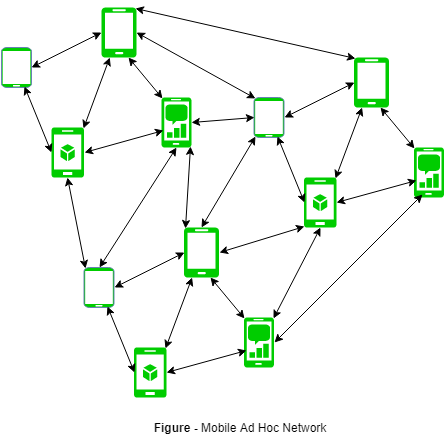1.特设网络:
自组织网络是由直接相互通信的各个设备组成的网络。该术语表示自发的或即兴的构造,因为这些网络通常绕过网守
硬件或中央访问点,例如路由器。许多自组织网络是局域网,在该局域网中,计算机或其他设备可以直接向彼此发送数据,而不必经过集中式访问点。

2.蜂窝网络:
蜂窝网络或移动网络是分布在称为小区的陆地区域上的无线电网络,每个无线电区域至少由一个固定位置的收发器(称为小区站点或基站)提供服务。目前,诸如GSM / CDMA / HSPA / LTE的发送小区远程系统是基础类型。小区组织由称为基站的焦点元素和称为移动订户(MS)的手机组成。在MS-A需要与MS-B通话的情况下,通过基站(BTS)进行通信,如图所示。它遵循六边形图案。

让我们看看蜂窝网络和Ad hoc网络之间的区别:
| S.NO | Cellular Network | Ad hoc Network |
|---|---|---|
| 1. | The network routing of cellular network are centralized, all the traffic goes through the base station. | The network routing of adhoc network are distributed, no centralized system such as base station needed. |
| 2. | Circuit Switching are used. | Packet Switching are used. |
| 3. | It has single hop type. | It has multiple hopes |
| 4. | Star topology are used. | Mesh topology are used. |
| 5. | It takes Higher cost and takes more time for deployment. | It takes lower cost and does not take more time for deployment. |
| 6. | It is used in Designed and developed for voice traffic. | It is used in Designed to meet best effort data traffic requirements. |
| 7. | Here Low call drops during mobility due to seamless connectivity across region. | Here higher breaks in the path during mobility. |
| 8. | It requires periodic maintenance so it is costly. | Here nodes are self-organizing and hence it is less costly. |
| 9. | The allocation bandwidth is guaranteed and easy. | The allocation of bandwidth is based on shared channel using complex MAC algorithms. |
| 10. | IS-95, IS-136, GSM, Mobile WiMAX, CDMA, LTE technologies are used. | WLAN 802.11e technology are used. |